What Cut of Beef Is Bresaola
Bresaola is a famous Italian charcuterie used on antipasti plates, salads and just eaten simply with rocket, lemon juice and olive oil.
Similar to biltong, it's air-dried cured beef and the meat is never cooked. Making your own homemade bresaola is very simple even if you don't have special curing equipment.
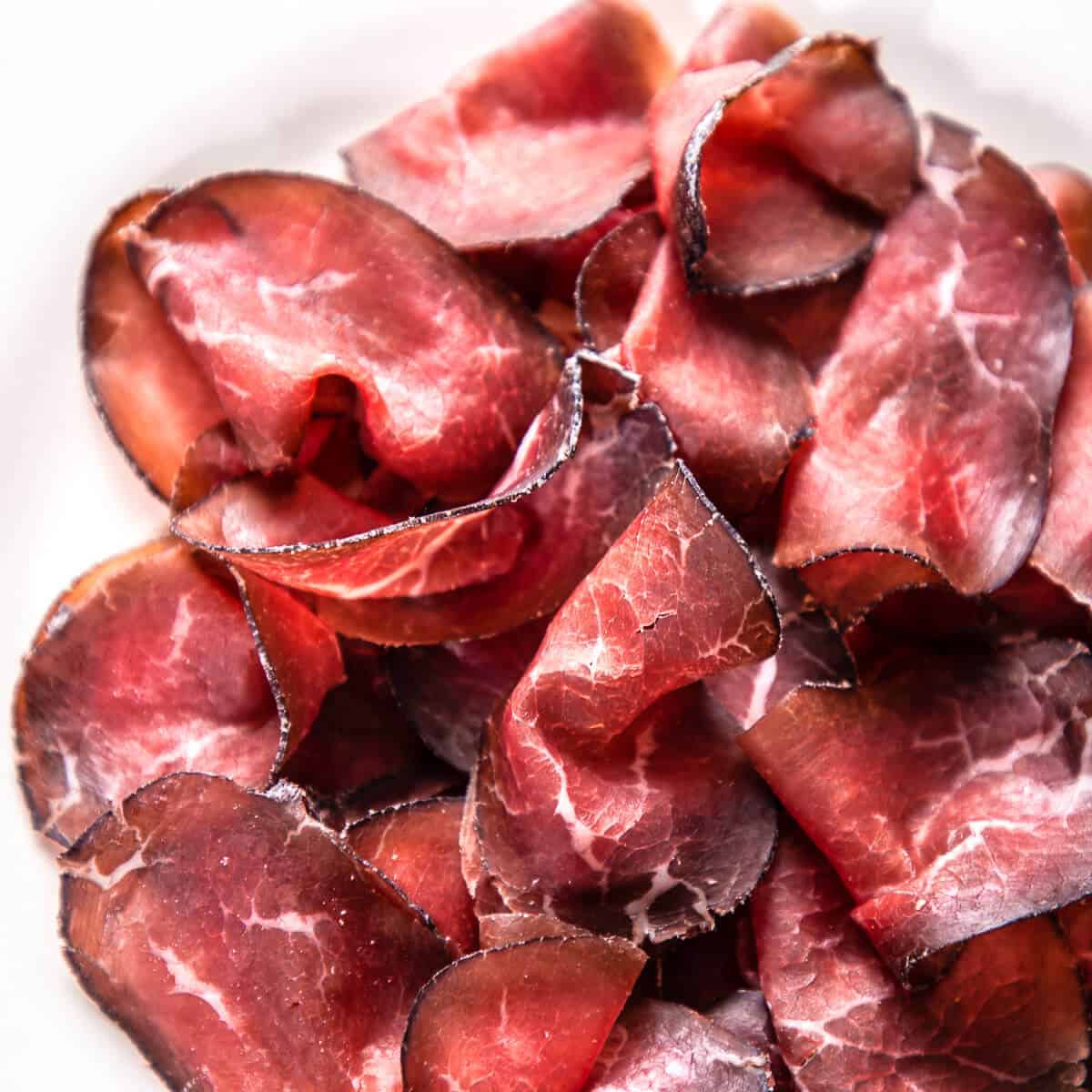
Jump to:
- What Is Bresaola?
- What does it taste like
- Bresaola vs. Prosciutto
- Choosing the best meat
- Useful equipment for curing
- Ingredients
- Salting and marinating
- Drying
- Options for drying
- Tips for success
- Varieties
- Serving suggestions
- Frequently asked questions
- Recommended charcuterie books
- Other curing and fermentation recipes
- More beef recipes
- Recipe
What Is Bresaola?
Bresaola, pronounced bre-zao-la, is an air-dried charcuterie that originated from the Lombardy region in northern Italy.
Different meats are used like horse, pork, venison and sometimes game birds. The most popular choice is beef though.
The meat goes through a salting stage with aromatics like juniper berries, cinnamon, clove, garlic, marjoram, and citrus rind to name a few, followed by a dredge in red wine.
Finally, it's hung to slowly dry in a cool environment with a relative humidity of about 70 - 80% for 6 to 12 weeks depending on the size of the meat.
What does it taste like
Well made bresaola should have a fine layer of edible white chalky mould growing on the outside. This gives it a desirable "funky" flavour.
The texture is soft but the meat is not fatty as it's made with lean meat usually.
It has a lot of umami and the flavour is complex and matured.
The aromas from spices, citrus rind, herbs and red wine all combine to bring a delicious balance to perfect bresaola.
Bresaola vs. Prosciutto
The two types of charcuterie are very similar in style with the biggest difference being the ingredients used.
Bresaola is a singular whole muscle mostly from beef.
It's made with natural flavourings and has gone through a two-stage curing process. Traditionally it's also done in a beef bung(appendix).
Prosciutto is a whole leg of pork and is only salted with pure course salt before being hung up to naturally dry. The process takes much longer as the meat is much larger.
Both are delicious salumi(cured Italian Meats) in their own unique ways.
Choosing the best meat
Beef eye of round, known as the false tenderloin because of its shape, is the most popular choice.
Other cuts like loin and and tenderloin can also be used, but they are much cheaper so not best suited for curing.
Bresaola is traditionally a very lean cured meat and as we'll see in this recipe the excess fat is trimmed off.
It is however highly recommended you use marbled or grain fed beef. Marbled beef has more fat running through the meat and not just sitting on the muscle.
This means that the cured bresaola will be more tender and have more flavour than a leaner variety.
The choice varies from person to person with many preferring the leaner version for health reasons mainly.
Useful equipment for curing
You can make bresaola in your fridge. I've done it many times especially when no special equipment is available or simply don't fit in the kitchen.
If you want more control it's advised you make it in a chamber that is heating, humidity regulated and has some airflow.
I simply use a fridge and add temperature and humidity controllers to a humidifier, small space heater and fridge. It's the same setup I use to grow koji.
Simple and very effective.
Ingredients

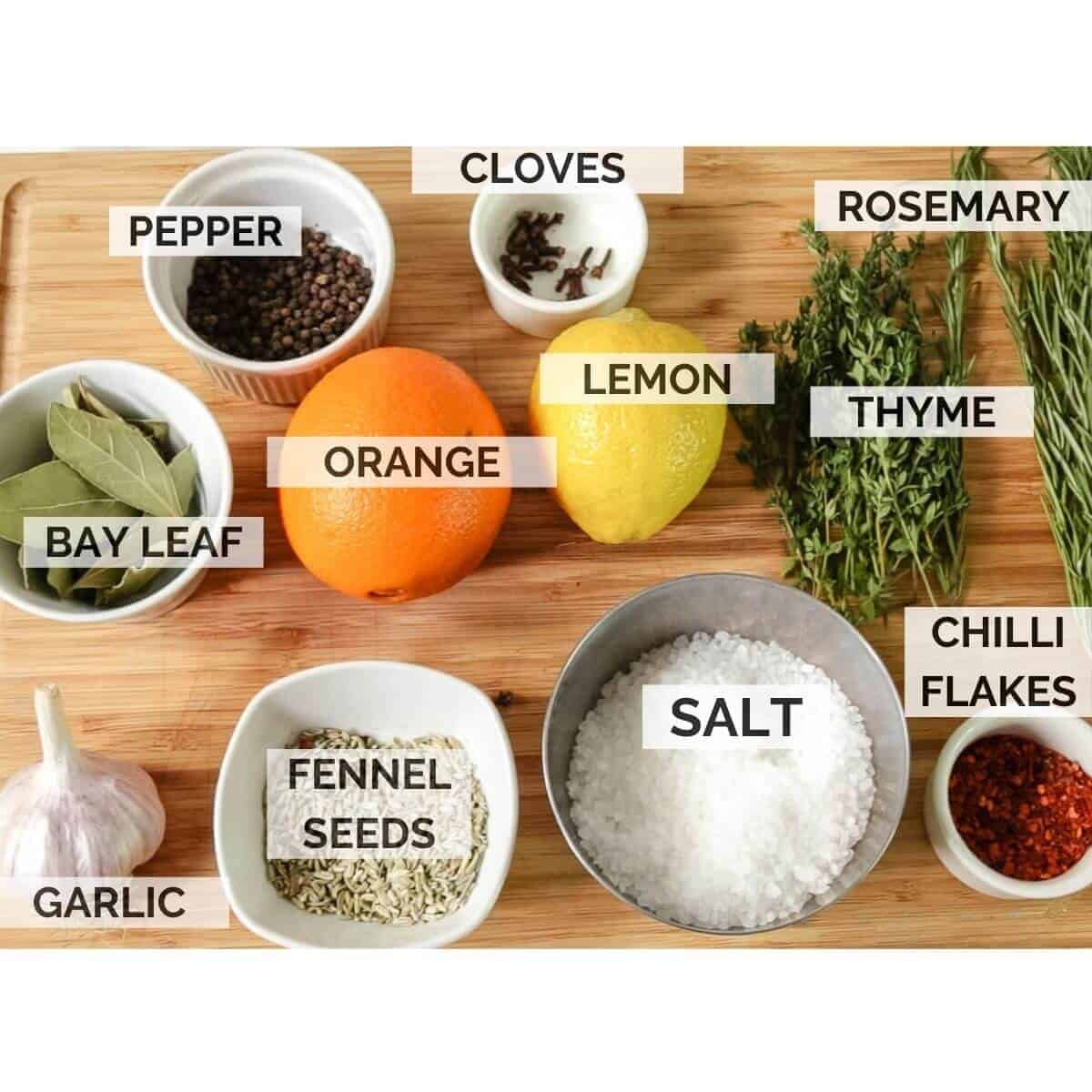
- Protein - Apart from beef you could use pretty much any other type but for this recipe, we will concentrate on using beef and the eye of round cut in particular.
- Aromatics - This is spices, citrus, herbs, whatever you want to put in there. There are no hard and fast rules so go with what you like. The traditional ones are juniper, rosemary, and black peppercorns.
- Salt - Some people add pink salt or Prague powder. There is no real need for it but if you want a safety net then add 0.5% to your salt mix. Salt always has to be kosher salt or natural non iodised course salt.
- Wine - Dry red wine is mainly used and gives the best results. Again play around with what you like but here traditional works best.
Salting and marinating
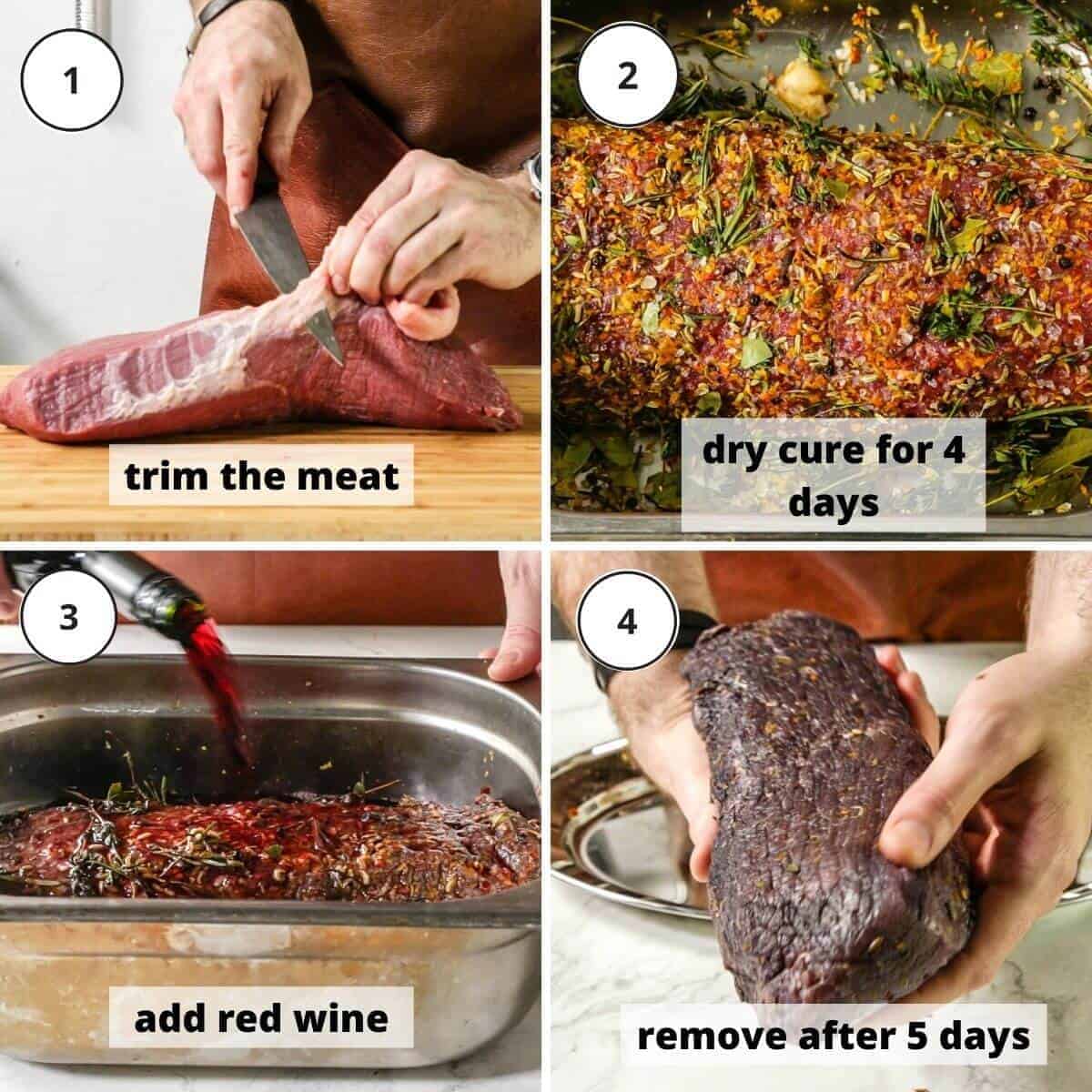
- Before you start make sure all your utensils, hands and work surfaces are spotlessly clean. We don't want to give bad bacteria a chance.
- Trim up the beef until you have a clean looking piece.
- Mix all the dry ingredients together.
- Place the beef with your salt mix into a food-safe non-reactive container like plastic or stainless steel.
- Massage the meat with the salt mix making sure to get it everywhere.
- Cover the container airtight and place it into the fridge for 4 days. Turning the meat once every day.
- On the 5th day add the red wine and place it back into the fridge. Covered airtight. Turn the meat once daily for 5 days.
- On the 6th day remove it from the fridge and wipe off any bits of herbs and spices. Do not wash it in water.
- Dry the meat on a paper towel and proceed to the next steps.
Drying
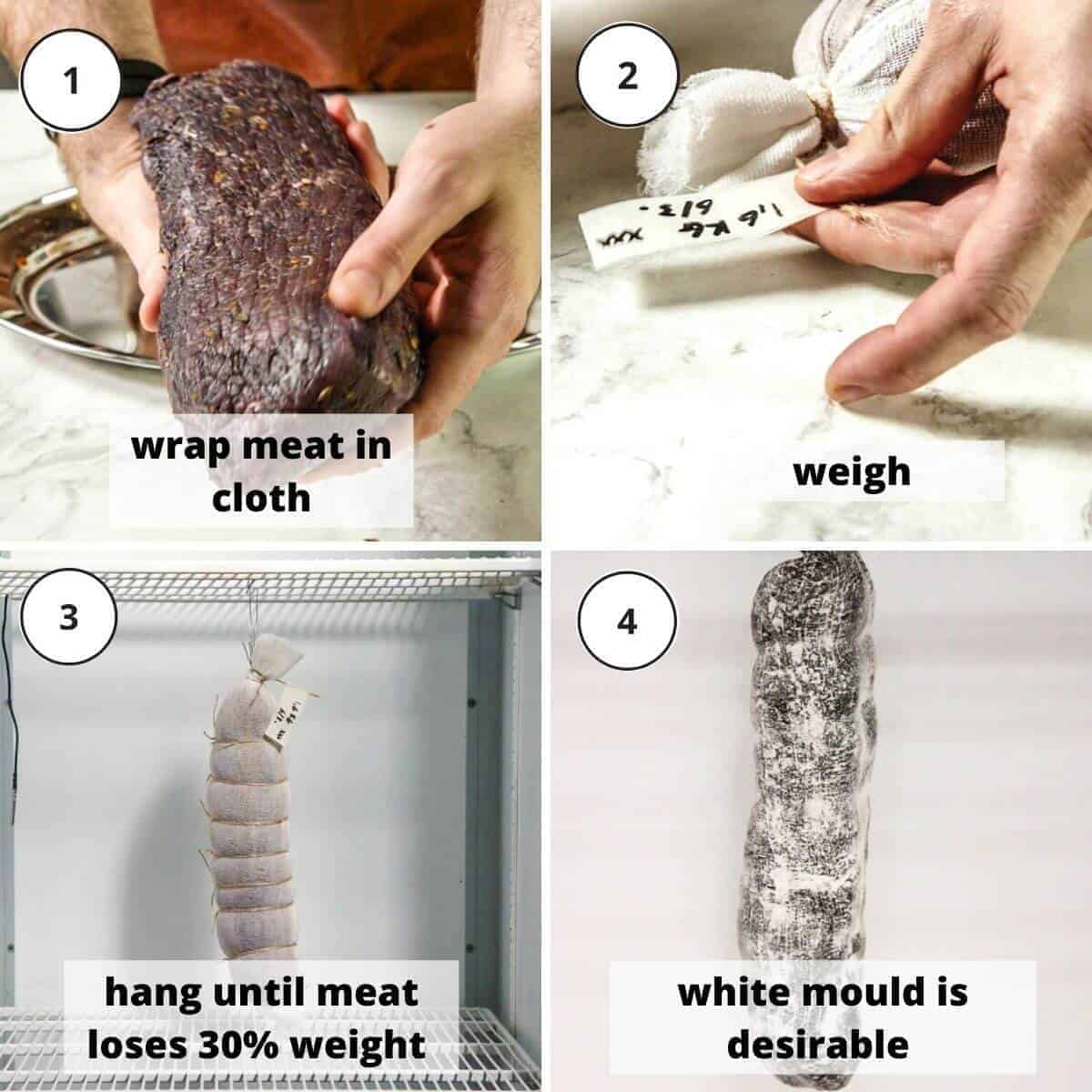
- Cut a piece of muslin cloth or breathable sterilised material.
- Wrap the meat in the cloth, tying it tightly with butcher's string all the way around.
- Weigh the meat and make a note of it. Don't worry too much about the weight of the cloth. It's minor.
- Hang the meat in your curing chamber or fridge for 5 days before optionally removing the cloth and continuing to hang it open. I do this so I can monitor and control any bad mould outbreaks and also so the good white mould has more surface to grow on.
- If Not simply keep curing and monitor the meat every few days to check for mould growth. If you see any other colour than white mould growing simply wipe it off with vinegar and keep monitoring it.
- Check the weight after about 4 weeks. The bresaola is ready when it has lost 30-40% of its weight.
Options for drying
- Outside - If you live in a not overly humid climate with mild to cool temperature you could do this in your shed. Just make sure it's safe from foxes and other animals. the idea is to create the same conditions one would find in the mountainous valleys bresaola comes from.
- Fridge - The cheapest and safest way. What I use when no curing chamber is available.
- Curing chamber - Requires a few simple pieces of equipment and for those that want to make cured meats or other charcuterie often.
Tips for success
- Cleanliness - Always work clean and sterilise your utensils. Working with raw meat is only risky when you let bad bacteria in.
- Meat Quality - Buy the best quality you can afford. Nothing can save a bad raw product. It has to be fresh and from a trusted source.
- Curing - Make sure there is some degree of airflow.
- Control - Monitor the bresaola while it cures. Don't just leave it and forget about it. You can save bresaola that has bouts of bad mould growth, but once it's full-blown you will have a hard time getting rid of it.
- Storing - Once cured, your bresaola will need to be kept away from direct sunlight and open air. You don't want it to dry out too much. The best way is to vacuum seal it cut it into smaller more manageable pieces.
- Case hardening - This happens when the bresaola dries out too quickly and the air is too dry. The outside becomes hard and the inside does not get a chance to lose moisture properly. This should not be a problem in most cases. If you see your bresaola drying out extremely fast on the outside you will have to move it to a more humid place or reduce the intensity of airflow a bit.
- Practice - Curing meat requires some practice and it's not always a straight forward path when doing it without a controlled environment.
Varieties
- Meat - Duck breast, Venison loin, Pork neck or belly, Lamb loin, Goat loin. These are all great contenders for this curing style. Take note that the smaller cuts will be done quicker than larger cuts. This is where weighing the meat before curing comes in handy. Aim for 30 - 40 % moisture loss.
- Wagyu bresaola - If you are fancy enough make it with wagyu beef. It's a treat you will never forget.
- Spices and aromatics - In this recipe, we use a few non-traditional as well as traditional bresaola making spices and aromatics. You can use and experiment with other spices, citrus and herbs or simply just use salt. Juniper berries, coriander seeds, cinnamon sticks and marjoram all work well.
- Wine - You can substitute the red wine for white wine or add some gin, whisky, brandy, sherry or port.
Serving suggestions
- Sandwiches - Makes a great bresaola sandwich on toasted focaccia or sourdough with fresh tomatoes, crisp salad leaves and caesar dressing.
- Antipasti - On a charcuterie and cheese board with marinated olives, parmesan sables, and eggplant dip.
- Salad - In a simple potato salad dressed with salsa verde.
- Appetiser - Bresaola carpaccio with rocket salad, lemon and olive oil. A classic.
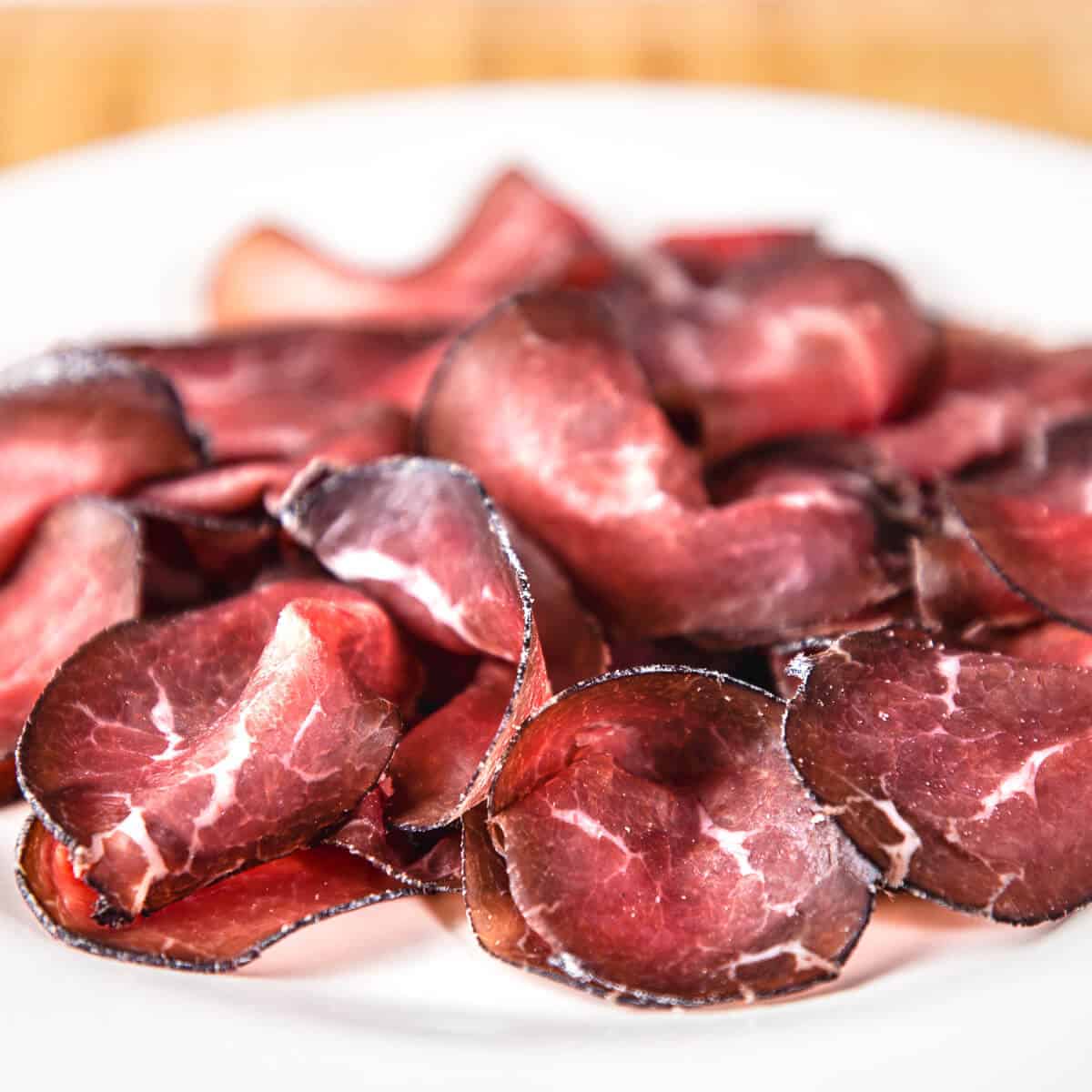
Frequently asked questions
How to store Bresaola?
The best option is to vacuum seal it and store it in the fridge. It will keep for many many months.
Alternatively, you could also store it in the freezer.
If your bresaola is slightly dry on the outside but perfectly cured inside you can even out the moisture by sealing in a vacuum bag and keeping it in the fridge for a few days.
How to slice it?
Bresaola needs to be sliced very thinly. The easiest way to do this is with a meat slicer.
If you do not have access to one simply slice it carefully with an extremely sharp knife.
It's not a must that the slices should be completely round so shave it off as thin as possible for the best eating experience.
Can I cook with it?
Bresaola does not need cooking but you can add it to pasta dishes instead of bacon, like in the famous Italian Carbonara.
Will it stay fresh sliced?
You can slice the bresaola and then store it vacuum sealed in portions. This is very convenient and and kept in the fridge it will last for many weeks sliced or simply store in the freezer for many months.
Recommended charcuterie books
Other curing and fermentation recipes
- Cured salmon gravlax
- Beef Biltong
- Fermented cucumbers
- Fermented carrots
-
Thai Beef And Pork Jerky (Video)
-
Homemade South African Droëwors - Beef, Venison And Pork (Video)
-
Sourdough Rye Starter Complete Guide
-
Ultimate Biltong Recipe - South African Beef Jerky (Video)
More beef recipes
- Filipino beef adobo
- Thai spiced beef koftas
- Bavette steak
- Ribeye steak
This site contains affiliate links. I may earn a tiny commission on qualifying purchases at no extra cost to you. By bookmarking these links you help support the upkeep of this site.
If you found this post helpful or have learned something, comment, subscribe, and follow me on social platforms for more tasty recipes.
Recipe
Italian Beef Bresaola
Bresaola is a fantastic cured meat that's simple to make. It's great on antipasti platter, charcuterie boards, and salads
Servings 20 portions
Prevent your screen from going dark
Meat
- 1½ to 2 kg (3 ⅓ - 4½ lb) beef eye of round - note 1
Dry cure
- 50 g (2 ⅘ tablespoon) course/kosher salt - 3% to weight of trimmed meat - note 2
- 6 g (1 teaspoon) cloves - note 3
- 8 g (1 tablespoon) chilli flakes
- 8 g (1 tablespoon) fennel seeds
- 8 g (1 tablespoon) peppercorns
- 8 (8 ) bay leaves
- 2 sprigs (2 sprigs) rosemary
- ½ bunch (½ bunch) thyme
- 5 cloves (5 cloves) garlic
- zest of 1 orange
- zest of 1 lemon
- 750 ml (3 ⅙ cups) dry red wine - note 4
Curing
-
Before you start make sure all your utensils, hands and work surfaces are spotlessly clean.We don't want to give bad bacteria a chance. (note 5)
-
Trim up the beef until you have a clean looking piece.
-
Mix all the dry ingredients together.
-
Place the beef with your salt mix into a food-safe non-reactive container like plastic or stainless steel. Massage the meat with the salt mix making sure to get it everywhere.
-
Cover the container airtight and place it into the fridge for 4 days. Turning the meat once every day.
-
On the 5th day add the red wine and place it back into the fridge. Covered airtight. Turn the meat once daily for 5 days.
-
On the 6th day remove it from the fridge and wipe off any bits of herbs and spices. Do not wash it in water.
-
Dry the meat on a paper towel.
Drying
-
Cut a piece of muslin cloth or breathable sterilised material. (note 6)
-
Wrap the meat in the cloth, tying it tightly with butcher's string all the way around.
-
Weigh the meat and make a note of it. Don't worry too much about the weight of the cloth. It's minor. (note 7)
-
Hang the meat in your curing chamber or fridge for 5 days before optionally removing the cloth and continuing to hang it open. I do this so I can monitor and control any bad mould outbreaks and also so the good white mould has more surface to grow on. (note 8)
-
If Not simply keep curing and monitor the meat every few days to check for mould growth. If you see any other colour than white mould growing simply wipe it off with vinegar and keep monitoring it.
-
Check the weight after about 4 weeks. The bresaola is ready when it has lost 30-40% of its weight.
-
Store airtight or slice thinly to serve. (note 9)
- Beef eye of round is the most popular cut to use. Other meats like duck, deer, venison, lamb and pork can all be used and cured in the same way. For larger pieces, it will take longer to cure and smaller pieces like duck breast will be done sooner.
- It's important to calculate the salt needed according to the weight of the trimmed meat. Simply take the weight of the meat and times it by 0,03. Or 3% of the weight of the meat.
- Traditionally juniper berries are used. You can also add cinnamon sticks or coriander seeds.
- You can also mix in a bit of brandy, port, sherry or whisky.
- Hygiene is key when curing meats as it's a raw product and does not go through heat treatment. Make sure to wash equipment, hands and surfaces thoroughly.
- Traditionally a cow bung is used but a breathable cloth work just as well and allows the white delicious mould to grow straight on the meat. Bresaola cured in a cow bung does not have the desirable mould on the meat as it gets removed to slice.
- Weighing the meat before you hang it to dry is crucial to determining when it's ready to eat. Aim for 30 - 40% weight loss.
- Dealing with unwanted mould is simple. Make sure there is some sort of airflow. Most fridges have a small fan. If any other mould than the white chalky kind grows, simply wipe it off with some vinegar and continue the curing process.
- Bresaola is best stored in vacuum bags in the fridge. It can also be presliced wafer-thin and kept in individual vacuum bags in the freezer.
Serving: 50 g Calories: 242 kcal Carbohydrates: 2 g Protein: 14 g Fat: 17 g Saturated Fat: 7 g Polyunsaturated Fat: 1 g Monounsaturated Fat: 7 g Cholesterol: 53 mg Sodium: 916 mg Potassium: 252 mg Fiber: 1 g Sugar: 1 g Vitamin A: 129 IU Vitamin C: 1 mg Calcium: 15 mg Iron: 2 mg
Keywords: beef, bresaola, cured meat
Save RecipeSaved!
Source: https://www.pantsdownapronson.com/beef-bresaola-recipe/
0 Response to "What Cut of Beef Is Bresaola"
Post a Comment